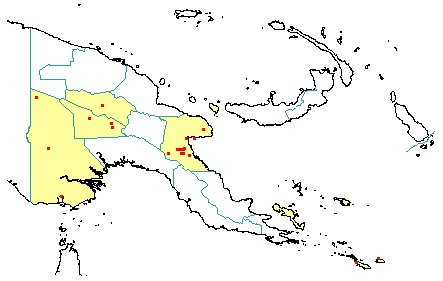
in PNGplants database
PNGTreesKey – Mischocarpus pyriformis Radlk. |
Barry Conn (NSW) & Kipiro Damas (LAE).
Guide to trees of Papua New Guinea
Copyright held by the authors, National Herbarium of New South Wales, and Papua New Guinea National Herbarium
Sitzungsberichte der mathematisch-physikalischen Classe der K. b. Akademie der Wissenschaften zu München Vol. 9: 647 (1879)
Other Literature: R.W.J.M. van der Ham, Flora Malesiana, Series 1 664-665 (1994) Fig. 58 (f).
Family: Sapindaceae
Dicotyledon
Timber Group: Non-timber species
Field Characters: Large canopy tree (up to 30 m high) or Small sub-canopy tree (sometimes large shrub); Bole markedly fluted (up to c. 35 cm diam.); crooked; buttresses buttresses present; spines spines absent; aerial roots aerial roots absent; stilt roots stilt roots absent; Bark brown, rough, pustular, lenticels irregular; Subrhytidome (under-bark) green; less than 25 mm thick; bark blaze consisting of one layer; faintly to non-aromatic; unpleasant (slightly acrid); outer blaze pale brown, markings absent, granular without splinters; inner blaze pale brown, markings absent, granular without splinters; bark exudate (sap) present, colourless, flowing, colour not changing on exposure to air, not sticky; terminal buds not enclosed by leaves.
Indumentum: Complex hairs absent; stinging hairs absent; mature twig indumentum (hairs) absent.
Leaves: Leaves spaced along branches, spiral (leaves occurring singly at a node and arranged spirally up the branchlet), compound (a leaf made up from two or more leaflets); petiole present, not winged, attached to base of leaf blade, not swollen; leaves pinnate (unbranched with more than three leaflets); petiolule not swollen; rachis present, absent, absent; leaves without a terminal leaflet (the number of leaflets even - paripinnate), broadest below middle or usually broadest at or near middle, (3.5-) 7.0-14.0 (-18.0) cm, 1.2-7.0 cm, sub-leaflets opposite or leaflets alternate, symmetric; venation pinnate, secondary veins open, prominent, intramarginal veins absent; leaves lower surface green, upper surface dark green (glossy), indumentum (hairs) absent; absent; domatia absent or present, scattered along midrib (when present, then usually restricted to axils of basal secondary veins); stipules absent.
Flowers: Inflorescence axillary or sub terminal, flowers on a branched axis, cones absent; flowers unisexual, unisexual with male and female flowers on the same plant, stalked, flowers with many planes of symmetry, 1.5-2.0 mm long, diameter small (up to10 mm diam.) (c. 1.5 mm diam.); perianth present, with distinct sepals and petals whorls, inner perianth yellow; 0-5, free; stamens 7-8, present, free of each other, free of the perianth; ovary superior, carpels joined (when more than one), locules 3; styles solitary (separated distally into 3 parts), 1.
Fruits: Infrutescence arranged on branched axis, fruit 20.0-35.0 mm long, 20.0-30.0 mm diam., green (dark (possibly immature) or orange, not spiny, slightly fleshy or non-fleshy, simple (basal part of fruit is long-tapering; seed-bearing part approximately globular), dehiscent, capsule; seeds 1 (covered with orange-red aril), about 10 mm long (6-7 mm long), not winged, broad (as wide as long), seed 1-10 mm diam. (c. 5 mm diam.).
Distribution: Morobe, Western Highlands, Southern Highlands, Western & Papuan Islands.
 | Botanical records in PNGplants database |
Notes: Notes Two subspecies are recognised as occurring in Papua New Guinea, namely: subsp. papuanus (Radlk.) R.W.Ham and subsp. retusus (Radlk.) R.W.Ham. The former subspecies have leaflets with long and slender acumens, domatia absent or 1 or 2 small ones in axils of basal secondary veins, and anthers glabrous or with a few hairs present; whereas, subsp. retusus have leaflets that are retuse or subacute to shortly acuminate, conspicuous domatia in some of axils of secondary veins, and anthers hairy. Subspecies papuanus is recorded from the Morobe, Western and Gulf provinces. Subspecies retusus is recorded from the Morobe, Western, Western Highlands, Southern Highlands and Papuan Islands. The third subspecies, subsp. pyriformis is restricted to eastern Queensland and New South Wales (Australia).